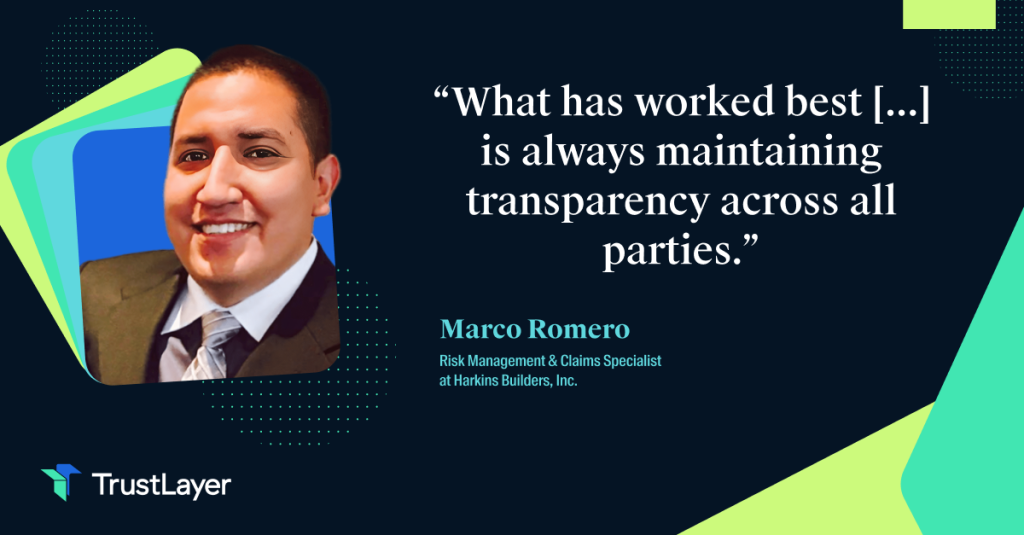Marco Romero: Communicating Away Risks

On the latest episode of Risk Management: Brick by Brick, Jason Reichl is joined by Marco Romero, Risk Management & Claims Specialist at Harkins Builders, a leading construction management and general contracting firm. Prior to joining Harkins, Marco spent nearly a decade working in Risk Consultancy at Simmerer Insurance. With such a strong background, Marco is a trusted advisor within his company and beyond.
https://youtu.be/VHVktC36Nrk?si=ycbtNAI1mdNBjsqY
In this episode, Jason and Marco discuss the importance of effective communication, gathering information, and using tools such as centralized data systems to manage risk. Further, they touch on the future of risk management in the construction industry, and the potential for automation to make the life of a risk manager easier.
Transparency in Risk Management
Risk managers have a lot to deal with in their day-to-day work. So when something goes wrong, and the unexpected happens, it is important to know exactly how to resolve the situation. Preparedness is key. Asking questions to the experts across your team’s departments will help you to know how and when to act, should things go wrong. Keep a transparent and open communication channel at all levels and times and hopefully you will avoid these situations as much as possible.
But that doesn’t help you in the moment when things actually do go wrong, does it?
Truthfully, it does.
Transparency is especially key in that situation, Marco says that at Harkins “what has worked best […] is always maintaining transparency across all parties”. Let’s delve into this. Imagine you are sitting in a brick room, alone. You are working with two of your friends to bake a cake. They are both also in brick rooms, alone. In front of you is the recipe. One of your friends has the equipment, and the other has the ingredients. None of you can leave your rooms until the cake has been baked. It’s an impossible task. That is what it is like trying to resolve a situation that went awry without open and transparent communication. Every member of the team, from the insurance carrier to the risk manager, is working towards the same goal, so why wouldn’t you keep a transparent line of communication? Don’t put up the brick walls; keep everyone in the loop.
“So transparency, I think, is what works best is when everyone really feels like they’re being […] kept in the loop. That’s what has been helping everybody get to the finish line in the most effective way”.
Effective Collaboration with Vendors
Risk managers, particularly in the construction industry, have to work with external vendors regularly. Marco believes that viewing this relationship as a partnership is key to success. Speaking on the matter Marco states “we really see all of our Trade Partners as true partners in the projects that we’re building”, so it is imperative that engagement and collaboration are fostered at every step of the process. In the world of Zoom and email, it would be easy to keep all communication remote, but will that form a true connection between yourself and your partners? Marco says no.
To him, the most beneficial way to foster these engaged and collaborative partnerships is to introduce face-to-face meetings wherever possible, or telephone if the former is not possible. Further, it is easy to think that it is unnecessary to bring individuals into the meetings until it is at the point where they will be actively contributing, but this could be your downfall. All of you are working towards the same goal, whatever that may be, so try to avoid keeping anyone in the dark.
“I think effective communication just involves picking up the phone, getting in front of people, holding the right meetings. All of that, I think, put together is what really makes those partnerships thrive”.
Also, remember that not everyone will be an expert in insurance matters, so lay clear any expectations and processes that will be involved, answering any questions to show them that you are someone they want to work with.
Keeping an open line of communication is imperative to everything you do as a risk manager.

